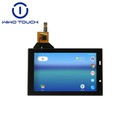The Internet of Things (IoT) is a networked system that connects a variety of physical devices, sensors, software, and other technologies via the Internet, enabling them to communicate and exchange data with each other. Simply put, IoT is a technology that connects and controls a variety of physical devices via the Internet, enabling them to operate and interact in an automated and intelligent manner. The core idea of IoT is to enable everyday objects (e.g., household appliances, automobiles, industrial equipment, etc.) to be connected and communicated with via the Internet for intelligent, automated control and management. These items are connected through embedded sensors, software, and networks that can collect, exchange, and analyze data to enable more efficient and smarter functions and services. The IoT has a wide range of applications covering various fields such as home, city, industry, agriculture and healthcare.
The specific application of touch screen on the Internet of Things is very extensive, it serves as an important interface for human-computer interaction, providing great convenience for the operation and control of Internet of Things devices. The following are a few specific application scenarios of touch screen on the Internet of Things:
1. Smart home: touch screen is often used as the central control panel of the smart home system, users can directly control a variety of smart devices at home through the touch screen, such as lighting, air conditioning, curtains, security systems and so on. The intuitive and convenient nature of the touch screen makes the operation of the smart home simpler and more efficient.

2. Automated industry: In industry, touch screen can be used to monitor and control all aspects of the production line. Workers or managers can view real-time production data, equipment status and other information through the touch screen, and remote control and adjustment. The real-time and visualization characteristics of the touch screen help to improve production efficiency and management level.

3. Smart City: In the construction of smart city, touch screen can be used for public information terminal, transportation management, environmental monitoring and other aspects. For example, in the bus station or subway station set up a touch screen inquiry machine, passengers can use the touch screen to query the bus line, arrival time and other information; in the environmental monitoring station set up a touch screen display, real-time display of air quality, temperature and humidity and other environmental data.

4. Intelligent medical equipment: In the medical field, touch screen can be used for the operation interface of intelligent medical equipment. Medical personnel can accurately control and operate the medical equipment through the touch screen, and at the same time, the touch screen can also display the patient's physiological parameters, the progress of treatment and other information to provide support for medical decision-making.

5. Intelligent vehicle-mounted terminal: In the automotive industry, touch screen has become the main operating interface of vehicle-mounted terminal. Drivers and passengers can control the in-vehicle entertainment system, navigation system, air conditioning system and other equipment through the touch screen to realize a more convenient and intelligent driving experience.

Touch screen has a profound impact on the development of the Internet of Things, mainly reflected in the following aspects:
1. Promoting the intelligence and convenience of human-computer interaction
Intuitive operation: as an intuitive input device, the touch screen greatly simplifies the interaction process between users and IoT devices. Users only need to touch, click, slide and other simple actions to realize the operation of the device, improving the convenience and efficiency of use.
Diversified application scenarios: The wide application of touch screen has promoted the rapid development of IoT in many fields, such as smart home, smart office, smart medical, smart industry and so on. For example, in the smart home, users can control lighting, air conditioning, security systems and other equipment through the touch screen to achieve intelligent management of the home environment.
2. Promote the popularization and interconnection of IoT devices
Reduce the threshold of use: the intuitiveness and ease of use of the touch screen reduces the threshold of the use of IoT devices, making it easy for more users with non-technical backgrounds to get started. This helps to popularize IoT devices and expand the market.
Seamless interconnection: Touchscreens combined with IoT technology enable seamless interconnection and data sharing between devices. Through the touch screen, users can easily access and manage multiple IoT devices, realizing unified management and control of devices.
3. Promote the innovation and development of IOT technology
Stimulate innovative applications: the wide application of touch screen provides a broad space for the innovation of IOT technology. For example, in the construction of smart cities, touch screen can be used for public information terminals, traffic management, environmental monitoring and many other aspects to enhance the intelligent level of urban management.
Promote technological progress: With the continuous development and improvement of touch screen technology, its response speed, sensitivity, durability and other aspects have been significantly improved. These technological advances provide strong support for the performance improvement and cost reduction of IoT devices.
4. Enhance user experience and satisfaction
Personalized customization: The touch screen supports users to personalize it according to their needs and preferences. For example, in the smart home, users can set the switching time and mode of lights, curtains, music and other devices according to their living habits, enhancing the comfort and convenience of life.
Real-time feedback: The touch screen can display real-time status information and feedback information of the device, helping users to understand the operation of the device and where the problem lies in time. This real-time feedback mechanism helps to improve user satisfaction and trust.




